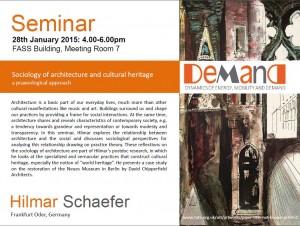 Hilmar, who is visiting DEMAND for three months, introduced a series of ideas about the relation between materials, practices, architecture and cultural heritage.
Hilmar, who is visiting DEMAND for three months, introduced a series of ideas about the relation between materials, practices, architecture and cultural heritage.
At first sight, these issues are only tangentially relevant to DEMAND, but the more he talked the more connections we saw. Some of these have to do with concepts of nature, culture and built forms. For example, methods of defining ‘world heritage’ tend to focus on sites/buildings though there are also cases of cultural heritage, including dance or food. In theory, we might imagine new forms of ‘energy related’ world heritage: perhaps including examples of naturally ventilated buildings plus the ways of life that sustain them or that they enable. What would it mean to ‘preserve’ such examples?
Other questions related to the role of materials and their status within, outside and as part of other structures including buildings. Hilmar talked about a temple made of wood that was regularly re-built (i.e. the timbers were replaced). The office work/office buildings project also deals with the layering and renovation of structures. The relation between unchanging designs, layouts and related practices, on the one hand, and ‘new’ materials is intriguing in terms of heritage.
The tobacco warehouses in Liverpool simultaneously represent heritage in building form, and in practice (to do with imports). So do the houses that Nicola, Lenneke and Anna have been investigating in Stocksbridge and Stevenage. Thinking about the parallels and differences generates other questions about where matters of energy lie: in the design of buildings and appliances, in the materials, in the changing patterns of use? The answer is obviously in all three, but how and what of the detail? Energy flows through buildings, and through the practices that populate buildings. Hilmar’s work prompts us to pause and think about the relation between these processes. In talking about these matters we referred to Tom Gieryn on what buildings do, and to Stuart Brand on how buildings learn.
Across DEMAND questions about the role of standards are coming to the fore. Hilmar talked about how decisions about world heritage are made and the criteria involved. The tension between a global endeavour – world heritage – and local instances e.g. unique sites has parallels with other discussions about what standards standardise, and how they work to unite and bridge between a multitude of specific instances.
Others will have picked up different ideas – but as Hilmar’s contribution shows, it is critical that DEMAND draws inspiration from a wide variety of sources, and that we do not become overly restricted by thinking about energy as a topic in its own right.

